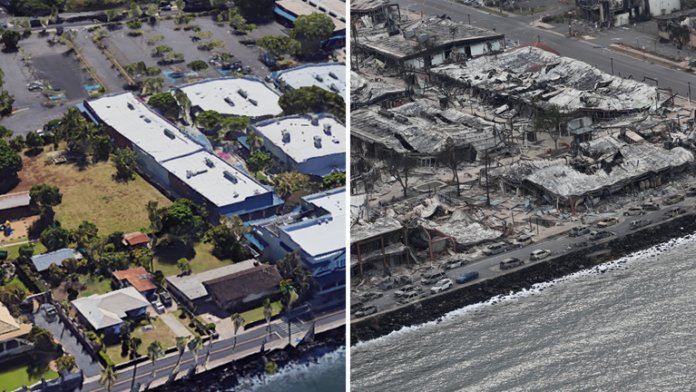With at least 53 people dead and hundreds of buildings damaged or destroyed, the dramatic and deadly wildfires on the Hawaiian island of Maui are a grim reminder of how climate change is increasing wildfire risk.
According to the National Weather Service, the fires on Maui are fueled by dry vegetation, strong winds and low humidity.
Wildfires are not common in Hawaii — the Guardian called the current ones “unprecedented” — because places with a wet, tropical climate do not typically have the dried-out vegetation to provide the fuel. But rising global temperatures are changing that. According to the organization Global Forest Watch, fires do not naturally occur in tropical rainforests, but as climate change has dried out forests, tropical forest fires have become more common, increasing by about 5% per year since 2001.
Heat
Average global temperatures have risen 2 degrees Fahrenheit since the Industrial Revolution, and this summer has been particularly scorching. Last month was the world’s hottest on record.
Hot weather dries out vegetation, effectively making it more vulnerable to fire. Extreme heat waves have recently contributed to unusually severe and early wildfires in Canada, which sent smoke across the northern United States.
In recent summers, the Pacific Northwest and Europe have also seen extreme heat and record-breaking wildfires, and this year is no exception.
“The situation in Hawaii recalled scenes of devastation elsewhere in the world this summer, as wildfires caused by record-setting heat forced the evacuation of tens of thousands of people in Greece, Spain, Portugal and other parts of Europe, and western Canada suffered unusually severe fires,” Reuters reported.
“Climate change in many parts of the world is increasing vegetation dryness, in large part because temperatures are hotter,” Erica Fleishman, director of the Oregon Climate Change Research Institute at Oregon State University, told the Associated Press. “Even if you have the same amount of precipitation, if you have higher temperatures, things dry out faster.”
Drought
When hotter air increases water evaporation, it pushes the water cycle towards extremes of heavy rainfall and droughts, both of which have become more intense in recent years.
A 23-year megadrought has left the Southwest at the driest it is estimated to have ever been in 1,200 years. Last summer, Europe experienced its worst drought in 500 years.
Even normally rainy areas such as the Northeast saw extreme droughts last year, while the area also experienced record-breaking extreme rainfall events and above normal precipitation months later.
Hawaii was in the midst of its own drought — an extremely rare occurrence for the tropical state — which raised wildfire concerns last fall. According to the U.S. Drought Monitor, moderate drought now covers more than one-third of Maui, with severe drought in some areas.
Hurricanes
Studies have also shown that warmer ocean waters caused by climate change help strengthen hurricanes. In this case, Hurricane Dora, which passed south of Hawaii this week, increased the difference in air pressure to create “unusually strong trade winds,” according to the National Weather Service.
By Thursday evening, Dora had spent 122 hours as a Category 4 hurricane, the most of any Pacific hurricane on record.
“When those strong winds hit, if you already have the heat and the dryness and if you have a spark, a wildfire becomes more likely to grow rapidly,” Fleishman told CNN.
Other human factors
When Europeans established farms in Hawaii, they brought fire-prone invasive grasses that now cover 26% of the state. The grasses grow quickly during the rainy season and then rapidly dry out if there is a drought.
“When we get these events like we’re seeing these past few days — when the relative humidity really drops low — all those fine fuels become very explosive,” University of Hawaii at Mānoa fire ecologist Clay Trauernicht told Wired.
Population growth and development are also increasing the number of places where forests and buildings sit side-by-side, increasing the deadliness of wildfires.
A window into the future
A 2022 report from the United Nations Environment Programme projected extreme fires to increase up to 14% by 2030, 30% by 2050 and 50% by 2100 if humankind continues on its current path of burning fossil fuels.
Unless nations swiftly and dramatically reduce the greenhouse gas emissions causing global warming, the recent increase in wildfires is just a small taste of worse things to come, experts say.
“This is our new reality,” Mike Flannigan, research chair for predictive services, emergency management and fire science at Thompson Rivers University in British Columbia, told Al Jazeera in June, about the Canadian wildfires. “We’re on a downward trajectory. Things are going to get worse and worse and worse.”







